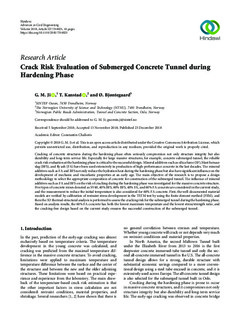| dc.contributor.author | Ji, Guomin | |
| dc.contributor.author | Kanstad, Terje | |
| dc.contributor.author | Bjøntegaard, Øyvind | |
| dc.date.accessioned | 2019-01-23T16:29:01Z | |
| dc.date.available | 2019-01-23T16:29:01Z | |
| dc.date.created | 2019-01-23T13:55:22Z | |
| dc.date.issued | 2018-12-23 | |
| dc.identifier.citation | Advances in Civil Engineering, Volume 2018, Article ID 7354025, 14 pages | nb_NO |
| dc.identifier.issn | 1687-8086 | |
| dc.identifier.uri | http://hdl.handle.net/11250/2582021 | |
| dc.description.abstract | Cracking of concrete structures during the hardening phase often seriously compromises not only structure integrity but also durability and long-term service life. Especially for large massive structures, for example, concrete submerged tunnel, the reliable crack risk evaluation at the hardening phase is critical to the successful design. Mineral additives such as silica fume (SF), blast furnace slag (BFS), and fly ash (FA) have been used extensively in production of high-performance concrete in the last decades. The mineral additives such as FA and BFS not only reduce the hydration heat during the hardening phase but also have significant influence on the development of mechanic and viscoelastic properties at an early age. The main objective of the research is to propose a design methodology to select the appropriate composition of concrete for construction of the submerged tunnel. The influence of mineral additives such as FA and BFS on the risk of cracking during the hardening phase was investigated for the massive concrete structure. Five types of concrete mixes denoted as SV40, 40% BFS, 60% BFS, 40% FA, and 60% FA concrete are considered in the current study, and the measurement to reduce the initial temperature is also considered for 60% FA concrete. First, the well-documented material models are verified by calibration of restraint stress development in the TSTM test by using the finite element method (FEM), and then the 3D thermal-structural analysis is performed to assess the cracking risk for the submerged tunnel during the hardening phase. Based on analysis results, the 60% FA concrete has both the lowest maximum temperature and the lowest stress/strength ratio, and the cracking-free design based on the current study ensures the successful construction of the submerged tunnel. | nb_NO |
| dc.description.sponsorship | The financial contribution of the Norwegian Research Council is gratefully acknowledged. The NOR-CRACK partners were the Norwegian University of Science and Technology (project leader), Skanska Norge ASA, Elkem ASA Materials, Norcem AS, Fesil ASA, and the Norwegian Public Roads Administration. The paper is mainly based on the PhD project performed by Guomin Ji [19]. | nb_NO |
| dc.language.iso | eng | nb_NO |
| dc.publisher | Hindawi | nb_NO |
| dc.rights | Navngivelse 4.0 Internasjonal | * |
| dc.rights.uri | http://creativecommons.org/licenses/by/4.0/deed.no | * |
| dc.title | Crack risk evaluation of submerged concrete tunnel during hardening phase | nb_NO |
| dc.type | Journal article | nb_NO |
| dc.type | Peer reviewed | nb_NO |
| dc.description.version | publishedVersion | nb_NO |
| dc.rights.holder | Copyright © 2018 G. M. Ji et al. This is an open access article distributed under the Creative Commons Attribution License, which permits unrestricted use, distribution, and reproduction in any medium, provided the original work is properly cited. | nb_NO |
| dc.source.volume | 2018 | nb_NO |
| dc.source.journal | Advances in Civil Engineering / Hindawi | nb_NO |
| dc.identifier.doi | 10.1155/2018/7354025 | |
| dc.identifier.cristin | 1663752 | |
| cristin.unitcode | 7566,7,0,0 | |
| cristin.unitname | Energi og transport | |
| cristin.ispublished | true | |
| cristin.fulltext | original | |
| cristin.qualitycode | 1 | |

